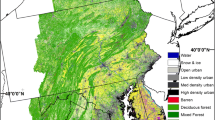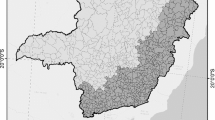Abstract
Forest managers in Canada need to model landscape pattern or spatial configurationoverlarge (100,000 km2) regions. This presents a scalingproblem, as landscape configuration is measured at a high spatial resolution,but a low spatial resolution is indicated for regional simulation. We present astatistical solution to this scaling problem by showing how a wide range oflandscape pattern metrics can be modelled from low resolution data. Our studyarea comprises about 75,000 km2 of boreal mixedwoodforest in northeast Alberta, Canada. Within this area we gridded a sample of 84digital forest cover maps, each about 9500 ha in size, to aresolution of 1 ha and used FRAGSTATS to compute a suite oflandscape pattern metrics for each map. We then used multivariate dimensionreduction techniques and canonical correlation analysis to model therelationship between landscape pattern metrics and simpler stand table metricsthat are easily obtained from non-spatial forest inventories. These analyseswere performed on four habitat types common in boreal mixedwood forests: youngdeciduous, old deciduous, white spruce, and mixedwood types. Using only threelandscape variables obtained directly from stand attribute tables (totalhabitatarea, and the mean and standard deviation of habitat patch size), ourstatistical models explained more than 73% of the joint variation in fivelandscape pattern metrics (representing patch shape, forest interior habitat,and patch isolation). By PCA, these five indices captured much of the totalvariability in the rich set of landscape pattern metrics that FRAGSTATS cangenerate. The predictor variables and strengths of association were highlyconsistent across habitat classes. We illustrate the potential use of suchstatistical relationships by simulating the regional, cumulative effects ofwildfire and forest management on the spatial arrangement of forest patches,using non-spatial stand attribute tables.
Similar content being viewed by others
References
Anonymous 2000. Criteria and Indicators for the Conservation and Sustainable Management of Temperate and Boreal Forests. The Montréal Process. The Montréal Process Liaison Office, Canadian Forest Service, Ottawa, Canada, [http://www.mpci.org/ meetings/ci/cie.html, accessed 09/29/2001].
Baker W.L. 1999. Spatial simulation of the effects of human and natural disturbance regimes on landscape structure. In: Mladenoff D.J. and Baker W.L. (eds), Spatial Modelling of Forest Landscape change: Approaches and Applications. Cambridge University Press, Cambridge, United Kingdom.
Boulinier T., Nichols J.D., Hines J.E., Sauer J.R., Flather C.H. and Pollock K.H. 2001. Forest fragmentation and bird community dynamics: inference at regional scales. Ecology 82: 1159-1169.
Canadian Council of Forest Ministers 2000. Criteria and indicators for sustainable forest management in Canada: National Status 2000. Canadian Forest Service, Ottawa, Ontario, Canada.
Cumming S.G. 1997. Landscape Dynamics of the Boreal Mixedwood Forest. PhD Dissertation, University of British Columbia, Vancouver, Canada.
Cumming S.G. 2000. Forest type, fire ignition, and fire frequency in boreal mixedwood forests. Working Paper 2000-11. University of Alberta, Edmonton, Alberta, Canada, Sustainable Forest Management Network, G208 Biological Sciences Building.
Cumming S.G. 2001a. Forest type and wildfire in the Alberta boreal mixedwood: What do fires burn? Ecological Applications 11: 97-110.
Cumming S.G. 2001b. A parametric model of the fire-size distribution. Canadian Journal of Forest Research 31: 1297-1303.
Cumming S.G. and Armstrong G.W. 2001. Divided land bases and overlapping forest tenure in Alberta, Canada: a simulation study of the costs of forest policy. The Forestry Chronicle 77: 501-508.
Cumming S.G. and Schmiegelow F.K.A. 2000. Dynamic reserve systems in exploited boreal forests. Abstract. In: Proceedings, Society for Conservation Biology 14th Annual Meeting, June-9-12, 2000., Missoula, Montana, USA.
Cumming S.G. and Schmiegelow F.K.A. 2001. Effects of habitat abundance and configuration, and the forest matrix, on distributional patterns of boreal birds. Working Paper 2001-1. University of Alberta, Edmonton, Alberta, Canada, Sustainable Forest Management Network, G208 Biological Sciences Building.
Cumming S.G., Burton P.J. and Klinkenberg B. 1996. Canadian boreal mixedwood forests may have no “representative” areas: some implications for reserve design. Ecography 19: 162-180.
Dix R.L. and Swan J.M.A. 1971. The role of disturbance and succession in upland forest at Candle Lake, Saskatchewan. Canadian Journal of Botany 49: 657-676.
Elkie P.C. and Remple R.S. 2001. Detecting scales of pattern in boreal forest landscapes. Forest Ecology and Management 147: 253-261.
ESRI 1998. ArcView GIS Version 3.1. Environmental Systems Research Institute, Inc., Redlands, California, USA.
Gillis M.D. and Leckie D.G. 1993. Forest inventory mapping procedures across Canada. Information Report PI-X-114.Petawawa National Forestry Institute, Forestry Canada, Chalk River, Ontario, Canada.
Global Forest Watch Canada 2000. Canada’s forests at a crossroads: An assessment in the year 2000. World Resources Institute, Washington, DC, USA.
Hair J.F., Anderson R.E., Tatham R.L. and Black W.B. 1995. Multivariate Data Analysis. 4th edn. Prentice-Hall, Englewood Cliffs, New Jersey, USA.
Kabzems A., Kosowan A.L. and Harris W.C. 1986. Mixedwood section in an ecological perspective. Technical Bulletin 8. 2nd edn. Saskatchewan Parks and Renewable Resources, Forestry Division, Regina, Saskatchewan, Canada.
King A.W. 1991. Translating models across scales in the landscape. In: Turner M.G. and Gardner R.H. (eds), Quantitative Methods in Landscape Ecology. Springer-Verlag, New York, New York, USA.
Kremsater L.L. and Bunnell F.L. 1999. Edges: theory, evidence, and implications to management of western forests. In: Rochelle J.A., Lehmann L.A. and Wisniewski J. (eds), Forest Fragmentation: Wildlife and Management Implications. Brill, Leiden, Netherlands.
Kurz W.A., Beukema S.J., Klenner W., Greenough J.A., Robinson D.C.E., Sharpe A.D. et al. 2000. TELSA: The tool for exploratory landscape scenario analyses. Computers and Electronics in Agriculture 27: 227-242.
Lehmkuhl J.F. and Raphael M.G. 1993. Habitat pattern around northern spotted owl locations on the Olympic Peninsula, Washington. Journal of Wildlife Management 57: 302-315.
McGarigal K. and Marks B.J. 1995. Fragstats: Spatial pattern analysis program for quantifying landscape structure. General Technical Report PNW-GTR-351. US Forest Service Pacific Northwest Research Station, Oregon, Portland, USA.
McGarigal K. and McComb W.C. 1995. Relationships between landscape structure and breeding birds in the Oregon Coast Range. Ecological Monographs 65: 235-260.
Maurer B.A. 1999. Untangling Ecological Complexity: The Macroscopic Perspective. University of Chicago Press, Chicago.
Mladenoff D.J. and Baker W.L. (eds) 1999. Spatial Modeling of Forest Landscape Change: Approaches and Applications. Cambridge University Press, Cambridge, UK.
Moss E.H. 1932. Vegetation of Alberta IV. The poplar association and related vegetation of central Alberta. Journal of Ecology 20: 380-415.
Riitters K.H., O’Neill R.V., Hunsaker C.T., Wickam J.D., Yankee D.H., Timmins S.P. et al. 1995. A factor analysis of landscape pattern and structure metrics. Landscape Ecology 10: 23-39.
Rowe J.S. 1972. Forest regions of Canada. Publication No. 1300. Canadian Forest Service, Ottawa, Ontario.
Rykiel E.J. Jr. 1996. Testing ecological models: the meaning of validation. Ecological Modelling 90: 229-244.
Schmiegelow F.K.A. 1997. The Effect of Experimental Fragmentation on Bird Community Dynamics in the Boreal Mixedwood Forest. PhD Dissertation, University of British Columbia, Vancouver, Canada.
Semenchuk G.P. (ed.) 1992. The Atlas of Breeding Birds of Alberta. Federation of Alberta Naturalists, Edmonton, Alberta, Canada.
StataCorp. 1997. Stata Statistical Software: Release 5.0. Stata Corporation, College Station, Texas, USA.
Strong W.L. 1992. Ecoregions and Ecodistricts of Alberta. ENR Technical Report T244. Alberta Forestry, Lands and Wildlife, Edmonton, Alberta, Canada.
Villard M.-A., Trzcinski M.K. and Merriam G. 1999. Fragmentation effects of forest birds: relative influence of woodland cover and configuration on landscape occupancy. Conservation Biology 13: 774-783.
Walters C., Gunderson L. and Holling C.S. 1992. Experimental policies for water management in the everglades. Ecological Applications 2: 189-202.
With K.A. and King A.W. 2001. Analysis of landscape sources and sinks: the effect of spatial pattern on avian demography. Biological Conservation 100: 75-88.
Author information
Authors and Affiliations
Rights and permissions
About this article
Cite this article
Cumming, S., Vervier, P. Statistical models of landscape pattern metrics, with applications to regional scale dynamic forest simulations. Landscape Ecol 17, 433–444 (2002). https://doi.org/10.1023/A:1021261815066
Issue Date:
DOI: https://doi.org/10.1023/A:1021261815066




